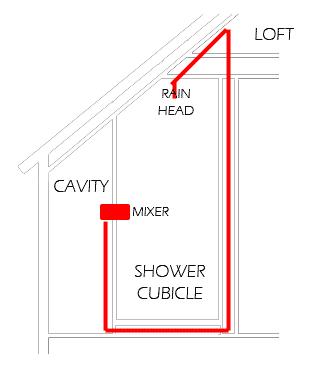When I moved to my house the ensuite shower was out of use due to a
stuck valve on one of the inlets
Anyway it was out of use, so I actually never tested it with it's original hose set up, and completely rebuilt the shower room, with a new cubicle and rain head before finally fixing the mixer and then finding it dribbled constantly.
I called Grohe support who (In the last month of warantee!) sent out an engineer who eventually had to replace the whole unit to get it to not run constantly.
That was 6 months ago. Recently it started to drip again, getting so bad recently that we've had to turn the water off to it, as it dribbles so much we can't sleep in the room next door!
I'm a little baffled, it can't be the cartridge/any washer as it's 6 months old.
I'm thinking (and this is where I need advice) that it's to do with my plumbing between the mixer and the rain-head.
My theory, that I'll test tomorrow is that if I disconnect outlet from the mixer it won't dribble. If that is the case then somehow water is getting pulled through the system due to the unusual shape that the pipe takes.
Here's my theory, can anyone advise if it's nonsense!:
Here's a diagram of the pipe to the rain-head (in red):
The sloping roof-space seemed impossible to run a pipe through, plus the ceiling above, so in the end I shaped a 15mm pipe with a couple of kinks and pushed it up into the loft space where it meets a vertical pipe, that runs under the shower tray and joins.
My crazy theory is that the last few feet before the rainhead, at 45 degrees, has water falling out of it when the shower is off, and somehow, even with the mixer turned off, the syphoning effect is enough to pull more water through.
Is this possible?
Or is there a much simpler theory? Why is it dribbling so much? How can I stop it! (Even with the head off it dribbles of of the pipe)
stuck valve on one of the inlets
Anyway it was out of use, so I actually never tested it with it's original hose set up, and completely rebuilt the shower room, with a new cubicle and rain head before finally fixing the mixer and then finding it dribbled constantly.
I called Grohe support who (In the last month of warantee!) sent out an engineer who eventually had to replace the whole unit to get it to not run constantly.
That was 6 months ago. Recently it started to drip again, getting so bad recently that we've had to turn the water off to it, as it dribbles so much we can't sleep in the room next door!
I'm a little baffled, it can't be the cartridge/any washer as it's 6 months old.
I'm thinking (and this is where I need advice) that it's to do with my plumbing between the mixer and the rain-head.
My theory, that I'll test tomorrow is that if I disconnect outlet from the mixer it won't dribble. If that is the case then somehow water is getting pulled through the system due to the unusual shape that the pipe takes.
Here's my theory, can anyone advise if it's nonsense!:
Here's a diagram of the pipe to the rain-head (in red):
The sloping roof-space seemed impossible to run a pipe through, plus the ceiling above, so in the end I shaped a 15mm pipe with a couple of kinks and pushed it up into the loft space where it meets a vertical pipe, that runs under the shower tray and joins.
My crazy theory is that the last few feet before the rainhead, at 45 degrees, has water falling out of it when the shower is off, and somehow, even with the mixer turned off, the syphoning effect is enough to pull more water through.
Is this possible?
Or is there a much simpler theory? Why is it dribbling so much? How can I stop it! (Even with the head off it dribbles of of the pipe)


